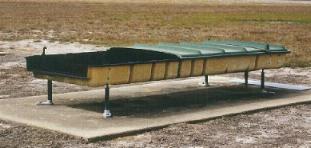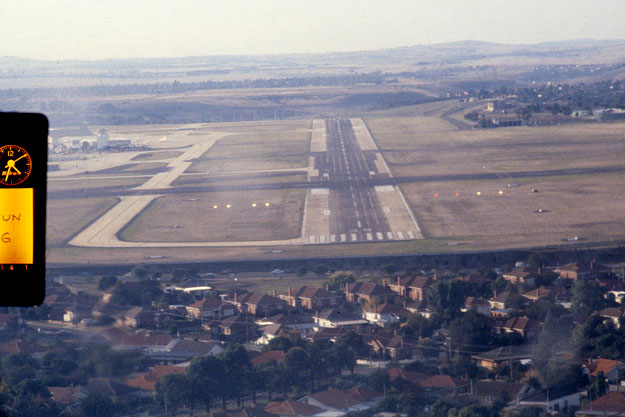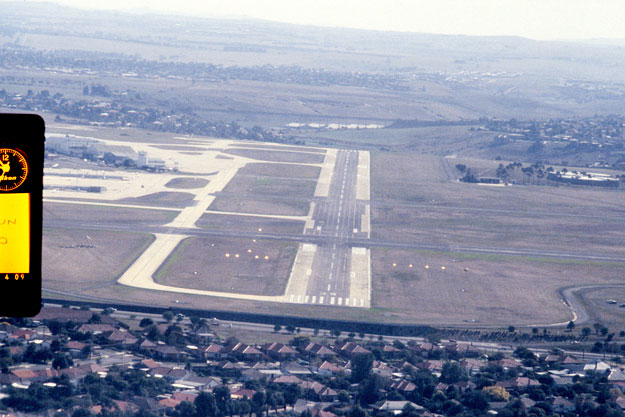by Roger Meyer
The T-Visual Approach Slope Indicator System (T-VASIS) is one of the three radio navigation aid inventions for which Australia is justly famous; the others being Distance Measuring Equipment (DME) and the Interscan Microwave Landing System (MLS).
From
a survey taken after the Second World War it was established that the majority of aircraft
accidents occurred during the approach and landing phase: in particular, the tendency
to ‘undershoot’ on landing. Alignment guidance extended from the centre-line
markings on the runway, but few visual cues were available for the pilot to obtain
the precise angle of approach. It was therefore necessary to improve piloting
techniques and/or to provide aids to the pilot while approaching to land.
The factors that made an accurate landing difficult to achieve were:
a) lack of ‘texture’ in the approach area
b) horizon obscured by
darkness, heavy rain or fog, and terrain
c) difference of level or poor contrast
between runway and surrounds
What
was required was a guidance system which would operate under changing ambient
conditions (night or day), and be visible at four miles from the runway threshold.
The possibility of developing glide path guidance by visual means arose from
a study of landing accidents initiated by the Department of Supply’s Aeronautical
Research Laboratories (ARL) in 1956 in consultation with the Department of Civil
Aviation (DCA). They undertook a long-term research study aimed at providing glide
path guidance by visual means for use at locations where no instrument landing
systems were available.
During 1957, field trials were conducted at Mangalore Airport, Victoria, to evaluate several systems including a three-colour (red, pink and white) angle of approach indicator, and a development of the aircraft carrier mirror landing sight. This investigation resulted in the development of an interim aid called the Precision Visual Glidepath (PVG), in which the pilot obtained slope information by aligning an elevated bar of lights with a bar of lights at ground level. A number of these systems were installed, but soon became redundant.
After discussions between ARL and DCA, the idea of the ‘T’ system was born. The first installation at Mangalore, with light units constructed of Masonite and Dexion metal framing, showed that the system was worthy of further development and, accordingly, patents were taken out in a number of countries.
During 1959 field development was transferred to Avalon Airfield, Victoria, where an advanced version of the Mangalore system was installed, together with the PVG and the Royal Aeronautical Establishment’s red-white Visual Approach Slope Indicator System (VASIS). The red-white VASIS indicated the correct slope to a pilot by means of two horizontal bars of light which changed colour from red to white as the angle increased. Twelve airline and service pilots evaluated the systems, using two DCA DC-3 aircraft. Based on the sensitivity of the light beam at varying distances from the runway, and the ability to interpret the ‘fly-up’ and fly-down’ indications, it was agreed that the T-VASIS was the best of the three.
At the time of the first meeting of the Visual Aids Panel of ICAO in 1960, the newly developed T-Visual Approach Slope Indicator System and the red-white system were demonstrated to delegates at the National Aviation Facilities Experimental Centre at Atlantic City, New Jersey. Subsequently in committee it was agreed that although the T-system had technical superiority, the fact that the red-white was in production was an important point, with a result that the UK red-white system was adopted as the ICAO standard until 1967.
In 1961 Runway 25 at Sydney Airport was equipped with a red-white VASIS (by now the ICAO standard) and an additional developmental model of the T-VASIS. Over many months all aircraft using this approach were tracked photographically to determine their height above threshold when landing. During alternating periods there was either no aid, a red-white VASIS or a T-VASIS. Subsequent statistical evaluation of results proved that although the red-white VASIS was a little better than no aid at all, the T-VASIS in turn provided considerably more accurate guidance to the aircraft.
As a result of this operational evaluation programme DCA decided to adopt the T-Visual Approach System, thus ending the scientific evaluation phase in which ARL had been involved. Departmental Engineers now took control of the programme in order to develop the equipment to production stage. Improvements included the provision of a frangible mounting, the addition of a red ‘undershoot’ warning indication and the development of a super-sensitive long level to enable the light unit to be adjusted to the precise angles required.
Tenders were called and finally in 1963 a contract was let to Reinforced Plastics Pty. Ltd. for six systems of a fibreglass light unit of a design known as Type A. The first of these production units was commissioned at Hobart Airport in 1964.

A typical T-VASIS Type C lightbox.
Click here for an enlarged view.
With the approaching introduction into service of long-bodied jets such as the
Boeing 747, it was necessary to find a suitable visual landing aid. T-VASIS was
acceptable as it provided, without modification, an indication of a higher, parallel
approach slope but the red-white VASIS required an extra bar of lights to be installed.
The enthusiasm of Australian and New Zealand airline pilots for T-VASIS obtained
the support of the International Federation of Airline Pilots, and this body did
much to encourage international acceptance of the system.
Subsequently, the Visual Aids Panel of ICAO at its meeting in February 1970 recommended the adoption of T-VASIS as an alternative standard. This recommendation was adopted by the Council of ICAO in March 1971 and became effective in January 1972. Thus ended a ten-year struggle to have T-VASIS accepted internationally. About 100 systems were finally installed in Australia, New Zealand, New Guinea and other countries.
In 1971 the T-VASIS was recognised as a significant contribution to aviation safety and was awarded the Prince Phillip Prize for Australian Design. The joint developers – DCA, and the system’s manufacturer, Reinforced Plastics - shared the prestigious award. Competition judges commented "The judges feel that this system will enhance the safety of jet flying and is a very real contribution to world aviation advancement".
In 1973, the Department of Transport (incorporating the former DCA) and ARL shared receipt of the Diplome d’Honneur of the Federation Aeronautique Internationale (FAI) for the invention and development of T-VASIS.
The Letters Patent for an "Improved glide path guidance means for aircraft" named the inventors as John Baxter and Ronald Cumming (from ARL), and Bruce Fraser and Dr John Lane (DCA).

The most interesting photograph above shows Melbourne/Essendon Runway 35 with a T-VASIS on the left hand side and a PAPI on the right. Both systems are showing 'on slope' indications (note the two red-two white colour indication on the PAPI).
In the photo below, both systems are indicating a gross 'fly down' flight-path error. Note the T-VASIS indication by means of additional lights showing an inverted 'T', whereas the PAPI relies on perception of a colour change to four white lights.

Finally, the image below shows both systems indicating a 'fly up' flight-path error. The T-VASIS is showing two lights forming an upright 'T', whereas the PAPI shows three red and one white light. The outstanding 'flyability' of the T-VASIS display is one of its best features.

Click
here to read the Pilot's Notes for T-VASIS
Back to the main Communications & Navigation Index
If this page appears without menu bars at top and left, click here